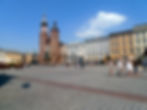Kraków: The Slavic Rome
- Mike McHugh
- Jun 16, 2012
- 4 min read
Hi All,
After getting a bit lost at the border between Slovakia & Poland, we finally arrived in Kraków at about 7:00 PM.
After checking into our hotel, we went to the Kazimierz, the old Jewish district of Kraków, for an included dinner. We had a soup, chicken entree, and a dessert called Passover cake. The chicken was amazing and the Passover cake was good once you got past the weird texture. My favorite part of the meal was the musicians playing traditional Polish songs.

Musicians performing during dinner
The following morning, we had a tour mostly on our Contiki bus with a few stops at 9:00 AM. We first returned to the same place we went last night, the Kazimierz to see it in the daylight. We learned that the Polish government, specifically that of Kraków, held propaganda campaigns to get the Jewish people to move into Poland in the thirteenth and fourteenth centuries because they recognized the fact that the Jews were hard workers and would put the city and country on the map. Quickly, though, the Jews fell victim to the same type of hate they experienced all over Europe and eventually decided to move into an enclosed area of the city, the Kazimierz. It was a prime piece of real estate as it was an island. When Hitler invaded Poland before World War II started, he forced all the Jews to move into the Jewish ghetto across the river in a much worse location. We also learned that the restaurant we ate at the night before was quite a famous restaurant and a few other stories about the area. Now, there are only 150 Jewish people in all of Kraków. It is a pretty sad story.


After the Jewish district, we went to the Jewish ghetto where we learned about a Polish, non-Jewish pharmacist that owned a pharmacy in the Jewish ghetto before it became the Jewish ghetto. He elected to stay and operate his pharmacy and helped many small babies escape the ghetto by first chloroforming them, putting them in his small toolbox, and carrying them out of the ghetto. The children were then adopted by Polish families.
We then passed by Oskar Schindler´s factory and headed into town to see the Royal Castle. It was amazing as you would never know you were in Poland at all! It was almost like you were back in the middle ages walking around the grounds of a very wealthy estate. The actual castle was designed by an Italian architect modeled after many different castles of Northern Italy. I felt like I was back in Italy.

Oskar Schindler’s Factory

Royal Castle

Royal Castle
Then, we walked to the Main Square where we saw the bugle call, also known as St. Mary’s Trumpet Call. Legend says that a guard in a clock tower saw an incoming army approaching early in the morning and only had a trumpet to warn the public. His bugle call alerted the townspeople and they were able to fend off the attack. Now, every hour on the hour, a trumpet player plays the traditional bugle call.

Main Square
After our tour ended, I grabbed lunch at a coffee shop with a few friends before heading back to Schindler´s factory. The factory has now been turned into a museum about the city of Kraków during German occupation. It tells the story not only of Oskar Schindler and his workers, but of the whole city. It was a pretty impressive museum and it was nice to see a somewhat happy story after being bombarded with depressing stories for the past two weeks during what I am calling my “Nazi and Communist Tour of Eastern Europe”.

Quote by Roman Polanski

Pots that were made in Oskar Schindler’s Factory
After the factory, we headed back into town to buy a few souvenirs and grab a refreshing smoothie. It was hot – about 95 degrees! Then, we met up with our group and headed to the famous Salt Mines of Kraków. We went 136 meters below the earth into the depths of the world famous salt mine. It was very impressive as they not only had salt everywhere, but they had pretty cool rooms, too. They had a bunch of life size displays showing how they mined the salt as well as a few huge rooms. There was a small chapel for miners to pray in and a full size church with amazing statues and engravings! I even saw an engraving of Da Vinci´s ˝The Last Supper˝! It was a very impressive tour. I was also happy because it was much cooler than it was above the earth. It was a great reprieve.



Chapel in the Salt Mines
After the salt mines, we headed back into the Main Square to grab a bite to eat for dinner. A few of us decided to have pierogis as they are a traditional Polish dish. I had never had perogis before, but they were pretty good. After dinner, we walked back to our hotel.
I really enjoyed Kraków. I did not know what exactly to expect, but I think that makes it exciting. Everything is a surprise. The city itself was not as dirty as I expected it to be and reminded me a bit of Rome. I am also in love with the exchange rate in Eastern Europe. Everything is so cheap!
Note: This post was originally published on June 18, 2012 in a blog entitled “Romeing Around Europe…Again” which chronicled my post-graduation trip across Europe.
.png)